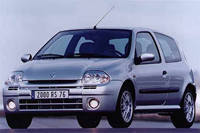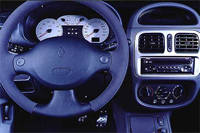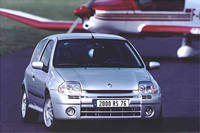Here is the offical announce of Renault Sport concerning the new Clio
Sport 2.0 16V:
Sports minded and elegantly turned out, with its 2 litre 175 bhp
engine plus comprehensive luxury equipment The Renault Sport 2 litre
16V Clio, a new flagship model for the Clio range The top vehicle
in its segment both in Europe and in France over the first nine months
of 1999, the Renault Clio stands out more than ever as a benchmark
model in the small car market. Now, in December 1999, Renault will
be marketing the 2 litre 16V Clio from Renault Sport. A cutting edge
version for the entire Clio range, the new arrival is an exclusive
combination of fast-forward sportiness and deep-seated elegance all
within the confines of a compact vehicle. Developed by Renault Sport,
with a key feature being its 2 litre 16V engine, boosted to 172 bhp,
this new member of the Clio range will enable all those on the look
out for a model that is both distinctive and forceful to rediscover
an authentic strand of driving pleasure.


Launched in 1998, the Clio is an out and out success and is standing
apart more than ever as a benchmark model in the "compact" segment.
Over the first 10 months of 1999, it was the most widely sold vehicle
across Europe in its category, enjoying a 10.5% market share in its
particular market segment. It has a lead over the Fiat Punto, the
Opel Corsa and the Peugeot 206. As at the end of October 1999, it
was also at the top of the sales list in France, with 8.1% of the
total market, ahead of the Peugeot 206 (6.9%), the Citroën Saxo (3.2%),
the Fiat Punto (2.6%) and the Opel Corsa (2.6%). Like Mégane and Scenic,
the Clio is a car destined to enjoy a full career on the international
scene too.
Alongside the manufacture and launch of a saloon version (the Clio
Symbol) in Turkey, the Clio will also be assembled in Brazil and sold
throughout the Mercosur region, notably in a special 999cc version.
A true "sport's hub" now enlarged Alongside the two grand touring
versions, the Si 1.6 90 bhp and the 16V 110 bhp, and the powerful
1.4 16V 98 bhp Tech'Run special edition, Renault is now introducing
a new version powered by a 16V 2 litre engine, developed by Renault
Sport. All of these versions of the Clio are intended to deliver a
heightened degree of driving pleasure - indeed, a very sporty one
in the case of the 2 litre 16V - without compromising in terms of
comfort and equipment. By virtue of special exterior and interior
design changes, these versions of the Clio also embody certain differentiating
features. During the 1990s, the former generation Clio had already
built its reputation on the basis of its broad range of sports versions.
Although the new Si and 16V Clios have replaced advantageously the
former Clio S and RSi versions, the new Renault Sport 2 litre 16V
model will more readily attract the former customers and those individuals
nostalgic for the ex-Clio 16V 137 bhp and the 150 bhp Clio Williams,
by being an even more finely crafted vehicle. In the year 2000, an
exclusive 250 bhp V6 24V version of the Clio will be marketed, featuring
a centrally-mounted engine.
Clio sports model range: old and new generation Clio 1 S 1.4 75 bhp
RSi 1.8 110 bhp 16V 1.8 16V 137 bhp Williams 2.0 16V 150 bhp Clio
II Si 1.6 90 bhp 16V 1.6 16V 110 bhp Renault Sport 2.0 16V 172 bhp
V6 24V 3.0 250 bhp.
Thoroughbred design blending sportiness with refined elegance The
Renault Sport 2 litre 16V Clio aims to reach an essentially male customer
base, fast moving, on the look out for a powerful, exclusively positioned
vehicle. It has a distinctive exterior appearance - at launch featuring
notably a titanium grey metallic finish as standard - which serves
to highlight the vehicle's dynamism and sporting temperament, without
being in any way "flash". The vehicle's design incorporates special
body-colour components, like the widened front wings in flexible composite,
bumpers with integral air intakes and additional fog lamps up front,
and the lower valance side skirts. At the rear, the window is topped
with a discrete sports spoiler and the Renault Sport signature adorning
the rear hatch. The bonnet is of aluminium, similar to the Clio 16V
version. A special development just for this version are the 15 inch
"Oz" light alloy wheels with 6 twin spokes. They are fitted with 195/50
tyres, amply filling the vehicle's wheel arches and visually reinforcing
its sporty look.
A particularly well crafted interior The vehicle's interior design
has been the focus of a particularly well crafted approach, incorporating
refined materials within a predominantly blue colour scheme: leather
and Alcantara for the upholstery, door panel inserts also in Alcantara,
leather bound steering wheel, aluminium tint inlays for the central
console and the door armrests. The vehicle's refined yet sporty personality
is further underscored by the inclusion of certain components fashioned
in aluminium, like the pad for the pedal assembly and the gear lever
knob. Rug, over carpets, the "Sport" upholstery on the seats and the
dashboard cover, all contribute to the blue colour scheme, contrasting
with the white background of the vehicle's instrument dials. To this
refined, value-added packaging of the interior is added an equipment
level that leaves nothing to chance. All essential items of equipment,
from a comfort and convenience point of view, come as standard (air
conditioning complete with heat-reflective windscreen and tinted windows,
electrically operated windows, central locking with radio frequency,
power assisted steering, integral Radiosat with either CD or cassette
player, etc). The only optional item is the 6 CD changer.


A 16V 2 litre engine with variable valve timing, powerful yet flexible
combining performance with frugal consumption The sporty, dynamic
credentials of this new Clio draw their strength equally from an optimised
chassis and a major advance in engine technology. The base engine
used in the development of this new version was the "F4R" 2 litre
16V unit, marketed on the Espace, Laguna and Scenic models. By applying
technologies honed in competition, particularly on the air induction
side, Renault Sport's engineers have been able to boost the power
and torque of this unit to 172 bhp at 6,250 rpm and 200 Nm at 5,400
rpm (compared to 140 bhp at 5,500 rpm and 188 Nm at 3,750 rpm). Belonging
to the "F" family of engines, this unit benefits, just like the 1.4/1.6
and 1.8 units, from the very latest innovations from Renault: valve
timing using roller cam followers to reduce friction (-50%), tubular
camshafts for an 800g weight saving and compactness thanks to redesigned
accessory mountings.
This engine also incorporates two-position inlet valve timing. The
system provides two settings for opening and closing the inlet valves
and enhances both cylinder filling and torque output at mid-range
speeds, without affecting power output at full load and at high speed.
Renault Sport's engineers have achieved the power gain by enhancing
the flow of gas in the air intake manifold. The goal was to enable
cylinders to inhale the largest possible quantity of air/petrol mixture,
in order to increase the engine's specific power output. the aluminium
inlet manifold has been increased in length with a plenum whose volume
increases from 3 to 4.8 litres to match the high speeds achieved by
this unit, the profile and section of the cylinder head ducts were
machined by Mécachrome, the valves, made from Nimonic (75% Nickel,
25% Chrome and Titanium), a technique derived from competition, retain
the former dimensions but offer resistance to high temperatures, the
platinum electrode spark plugs ensure more reliable spark generation
and better mixture ignition. The life of the plugs is extended to
120,000 km, valve timing has been changed.
Valve overlap is increased to achieve greater power output at high
speed, while the reduced overlap permitted by the variable valve timing
at low speed increases flexibility and idling stability, a special
4 in 1 tubular exhaust manifold feeds into two catalytic converters
mounted side by side. These solutions speed the flow of gases through
the exhaust system and avoid back pressure as they exit the engine.
The complete exhaust system, from manifold to rear silencer, is made
from stainless steel. With a capacity of 1998 cc, this 16 valve engine
develops maximum power of 124 kW (172 bhp) at 6,250 rpm, with maximum
torque reaching 200 Nm (20.7 mkg) at 5,400 rpm. To ensure a smooth,
pleasurable drive, 85% of maximum torque is available in a range extending
from 2,500 to 6,500 rpm and 95% of maximum power kicks in at 5,800
rpm, with little power loss beyond 6,250 rpm. When compared with the
"F7R" 2 litre 16V engine of the former Clio Williams, this new unit
delivers an extra 22 bhp and maximum torque increased by 25 Nm. As
for fuel consumption, on a mixed MVEG cycle, it is reduced by 0.2L/100
km.
Closer gear ratios The drive is taken through a manual JC5-type
5-speed gearbox. Closer gear ratios linked to the wide spread of engine
torque contribute to the sporting performance of this version. An
indicator light, mounted on the instrument panel, shows when optimum
use is being made of the gear changes so as to maximise engine performance.
The engine rev limiter takes into account the gear being used: 7,250
rpm in 1st and 2nd and 7,000 rpm in 3rd, 4th and 5th. Dynamic features
focused on driving enjoyment The characteristics of the engine allied
with an efficient chassis make this sport's version within the Clio
range a good all-round package, delivering driving pleasure to both
the most experienced of users as well as the everyday driver. The
Renault Sport 2 litre 16V Clio has the technical definition of all
the Clios. The front axle is of the MacPherson type, whilst at the
rear the principle of the flexible H-form torsion beam with trailing
arms is retained. The spring rates, anti-roll bar stiffness and damper
calibration are specific to the version and meet requirements in terms
of both performance and ride comfort.
The power steering is carried over from the 16V version of the Clio.
The increased dynamic capabilities of the new version are due to the
widening of wheel tracks, by 27 mm at the front and 17 mm at the rear,
which positions the wheels closer to the four corners of the vehicle.
Squatting firmly on its 15 inch light alloy wheels, fitted with broad,
low profile 195/50/15 tyres and a centre of gravity lowered by 15
mm, the Renault Sport 2 litre 16V Clio is agile, manoeuvrable and
powerful, at one and the same time.
The vehicle's overall dynamic handling potential has thus been increased
without adversely affecting ride comfort. The increased size of the
brakes meets the need for a powerful braking system, of sufficient
size to stand up to intensive use. The front disk brakes increase
in size from 260 to 280 mm and the rear system adopts the 228 mm diameter
disks. The latest generation ABS system comes as standard, in common
with the whole Clio range. It is linked to an electronic proportioning
system EBV delivering greater braking efficiency to the rear wheels.
Braking is reduced to a maximum degree with stopping distances under
40 metres on an AMS-type test, for example.
Passive safety identical to the other Clios As a complement to this
yet further improved active safety system, the Renault Sport 2 litre
16V Clio incorporates the full set of passive safety features common
to the entire Clio range. It is fitted as standard with the Renault
System for Restraint and Protection (SRP) which provides the front
seats with programmed restraint twin airbags and programmed restraint
seat belts with pretensioners and 400 daN load limiters. The side
head/chest airbags, fitted into the seat backs, also come as standard.
In the rear, the full safety system is rounded off with 3 headrests
and three three-point seat belts with 600daN load limiters for the
end seats, plus rear child seat with the Isofix fixing system in place.
Fine tuned manufacturing process at the Dieppe plant Designed by
Renault Sport, this new version is to be produced in the Alpine plant
at Dieppe in Normandy. This is a plant whose reputation for assembling
sports cars stands as second to none, and it is here that the final
assembly of the Renault Sport 2 litre 16V Clios will take place, at
the rate of 33 units per day. The Cléon plant will deliver the 16V
2 litre engines, whilst the plant at Flins will be shipping the body
shell complete with opening panels.
Competitive price tag Like the Clio range as a whole, the Renault
Sport 2 litre 16V version will have the benefit of a very competitive
price tag. Offered at a price of FRF 134,900 (20,565 Euros), the Renault
Sport 2 litre 16V Clio is coming onto the market then at the price
of the former 1994 Clio Williams (FRF 135,000) but as a more finely
tuned package with enhanced equipment.




